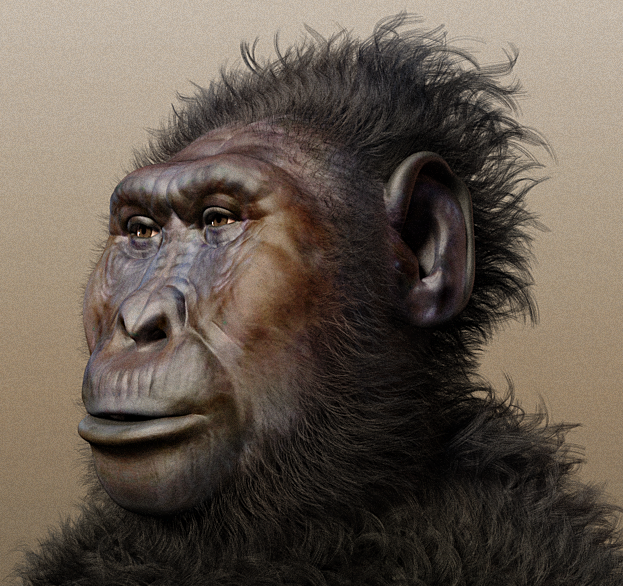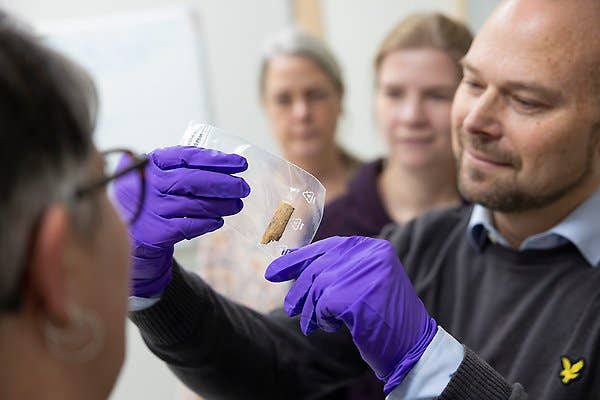Million-year-old fossil changes what we know about human hands and feet
Newly found fossils reveal Paranthropus boisei had human-like hands and feet, reshaping how scientists view early hominin evolution.

Newly discovered fossils in Kenya reveal that Paranthropus boisei, once seen as a simple plant-eater, had surprisingly human-like hands and feet—rewriting its place in human evolution. (CREDIT: Cicero Moraes / CC BY-SA 4.0)
For decades, Paranthropus boisei, an early hominin that roamed eastern Africa a million years ago, was known for its gigantic jaw and powerfully constructed biting muscles. Its coarse-grass and reed diet earned it the name "Nutcracker Man," but the remainder of its skeleton remained a mystery.
Now, fossils recently unearthed in the Turkana Basin of Kenya are giving scientists their first close-up glimpse of this ancient relative's hands and feet—and revealing a far more dexterous and earth-bound species than anybody expected.
A Million-Year-Old Puzzle Piece
Between 2019 and 2021, researchers, led by paleoanthropologist Carrie Mongle of Stony Brook University, discovered fossil remains near Kenya's Koobi Fora. The bones, labeled as KNM-ER 101000, date about 1.52 million years ago. They consist of both hand and foot components that were found side by side together with skull and tooth remains clearly of Paranthropus boisei. For the first time, scientists were able to identify these body parts as belonging to one individual with confidence.
Until now, debates had been raging over whether or not this species, long considered a close relative of early Homo, used or made tools. The absence of hand bones had left the question in doubt. Some have assumed all early hominins were tool users; others speculated that Paranthropus could be an exception. With these fossils, that doubt is fading away.
A Hand Built for Both Strength and Skill
When the scientists rebuilt the hand, they found an interesting combination of traits. The thumb was long, like in human beings of today, to allow for accurate movements like pinching or grasping small objects. But the bones were strong and robust, like gorillas. The joint at the base of the thumb and the bones in the wrist were extremely robust, suggesting a grip capable of generating uncredible pressure.
"The most surprising part," Mongle said, "was the number of ways that this hand was similar to our own." The proportions—long thumb, short fingers, and flexible little finger—predict the ability to hold onto things well and mold them with precision.
But the hand was not as advanced as that of later Homo species. Its joints suggest P. boisei may not have been able to develop the same precision for making fine tools. But the physical ability was there. The hand's structure "suggests some capacity for gripping that would have enabled the use of tools," whose movements were "more functional than technological," says Samar Syeda of the American Museum of Natural History.
Walking on the African Plains Upright
The fossil feet, for example, in the case of a solid big toe and a highly preserved metatarsal, tell a different story—one of confident bipedal walking. The big toe was angled for pushing off the ground, with the mid-foot showing a structural twist that supported a strong, arched step. These are signs of a creature adapted to walking upright on the ground, though still perhaps capable of some climbing.
With a well-defined arch and flat joint surface, this foot was not that of a forest dweller. Instead, it implies that of a hominin comfortable in the savanna, browsing between patches of food or dashing by lake edges.
The find also recharacterizes the Paranthropus as a oafish plant eater with little delicacy. Its robust hands might have had a multiplicity of other uses beyond eating hard plants. Researchers believe it might have employed rocks to open large seeds or strip bark, actions that were heavy-handed and synchronized.
Almudena Estalrrich of Spain's National Museum of Natural Sciences notes that muscular markings on the hand "evidence intense use, both for locomotion and food procurement." That suggests P. boisei was more versatile than previously thought, with physical strength and nimble hands.
Shared Ground with Early Humans
These fossils also confirm that Paranthropus boisei and early Homo coexisted more than a million years ago. Earlier footprints left behind in volcanic ash had already indicated this. Now, KNM-ER 101000 offers concrete evidence that these two species—one herbivorous and dependent on raw strength, the other tool-using and meat-experimenting—lived on the same planet at the same time.
Adrián Pablos of Spain's National Center for Human Evolution explains that this finding "changed the perspective that we had for this species and permits us to think about them more human and less about something else." The discovery discredits the long-standing belief that tool use or hand skill was the hallmark that differentiated Homo from other hominins.
Fossils also give clues to the nature of the last common ancestor of Homo and Paranthropus. The hand proportions show that early hominins already had large thumbs and robust grips before their split in evolution. Homo later refined these characteristics, developing the advanced wrist and finger systems which would be required for sophisticated tool-making.
To scientists, the discovery emphasizes how evolution did not go in a straight line from primitive to advanced. Instead, it was a complicated network of adjustments—some shared, some variable—that existed at once in time and space. "What used to be taken for granted has now been put under renewed scrutiny with new data and methods," Estalrrich explained.
Practical Implications of the Research
Aside from rewriting the textbooks, the find of KNM-ER 101000 enhances our knowledge of what makes Homo sapiens unique. It demonstrates that dexterity and tool usage didn't appear suddenly but developed gradually through experimentation on the part of a number of hominin species.
For evolutionary biology and anthropology, the fossil provides an unusual opportunity to observe how coevolution of anatomy and behavior occurred—how a species was able to evolve ground-walking economy and manipulative power without yet having perfected technology.
Lastly, it reminds us that human evolution was a group experience, one shaped by numerous hands before our own
Research findings are available online in the journal Nature.
Related Stories
- Ancient human fossils reveal a startling twist in evolutionary history
- Fossilized teeth reveal a risky diet change spurred human evolution
- Ancient tooth fossil reveals humans have been getting high for over 4,000 years
Like these kind of feel good stories? Get The Brighter Side of News' newsletter.
Joseph Shavit
Science News Writer, Editor-At-Large and Publisher
Joseph Shavit, based in Los Angeles, is a seasoned science journalist, editor and co-founder of The Brighter Side of News, where he transforms complex discoveries into clear, engaging stories for general readers. With experience at major media groups like Times Mirror and Tribune, he writes with both authority and curiosity. His work spans astronomy, physics, quantum mechanics, climate change, artificial intelligence, health, and medicine. Known for linking breakthroughs to real-world markets, he highlights how research transitions into products and industries that shape daily life.



